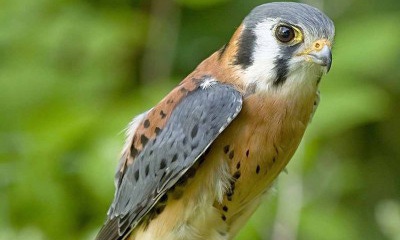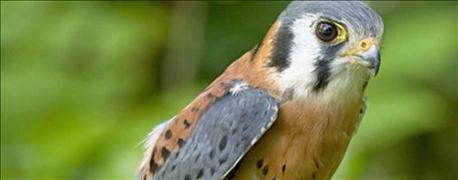July 7, 2016

In dry years like 2016, when other water sources are limited, birds many depend on fruit to a greater extent than usual to meet their energy requirements. A number of growers are reporting high bird activity in their fruit.

Providing nesting boxes for kestrals (pictured), which are known to feed on smaller, fruit-feeding birds, is a long-term strategy for reducing populations of birds that cause damage and crop loss on fruit farms. Photo: Greg Hume.
The quickest bird deterrents to deploy are auditory and visual scare devices, like units than play bird distress calls and inflatable tube men. Birds habituate to many deterrents quickly, however, so the devices are more likely to be effective if they go on and off randomly, are moved frequently and are used in concert. For example, a recent study showed that the deterrent effect of combined auditory and visual deterrents lasted more days for ring-billed gulls, which are known to eat fruit, compared to when a visual or auditory device was deployed on its own. Here are some bird management strategies:
•Keeping track of “hot spots” for bird activity on your farm and targeting those spots with sustained and vigorous deterrent effort may help.
•Harvesting ripe fruit in a timely manner will reduce the availability of the fruit to birds and may reduce losses.
•Light deterrents, like lasers, deter some bird species. However, keep in mind that evidence for their effectiveness has come primarily in low-light situations, like at dusk or at night.
•Strategies that take more lead time and investment include physical barriers like netting that can be employed in short-stature crops. Ideally, netting should be on a frame so it does not lie on the fruit and be anchored to the ground. Otherwise birds can still access the fruit.
•Over the long term, growers should think about habitat management. Work at Michigan State University has shown that in some contexts where there is less fruit, like edges of fruit blocks adjacent to non-fruit, the percent bird damage can be higher. Arranging blocks to minimize non-fruit edges could lower the amount of the crop at risk for bird damage.
•Growers can also consider improving habitat for species that may deter pest birds. The remains have been found of fruit-eating birds in nest boxes installed for American kestrels, which are small predatory birds in cherry orchards and blueberry fields. As an added benefit, kestrels eat voles and pest insects
•In very high-damage contexts, growers can consider applying for a permit for lethal control of birds. However, the permit application process may take a number of weeks. For more information, see “Do I need a permit to control wildlife on my farm?” by Michigan State University Extension.
The Federal Aviation Administration has new rules regarding Unmanned Aircraft Systems (drones) that will take effect in August 2016. Once drone technology is a bit less dependent on human direction, it may be useful in deterring birds.
Each farm is unique and should be assessed for potential risk factors. See pages 211-218, Sample Bird Management Plan, of “Managing Bird Damage to Fruit and Other Horticultural Crops” for more information.
For information about deploying kestrel nest boxes, please email me, Catherine Lindell, at [email protected].
Source: MSU Extension
You May Also Like




